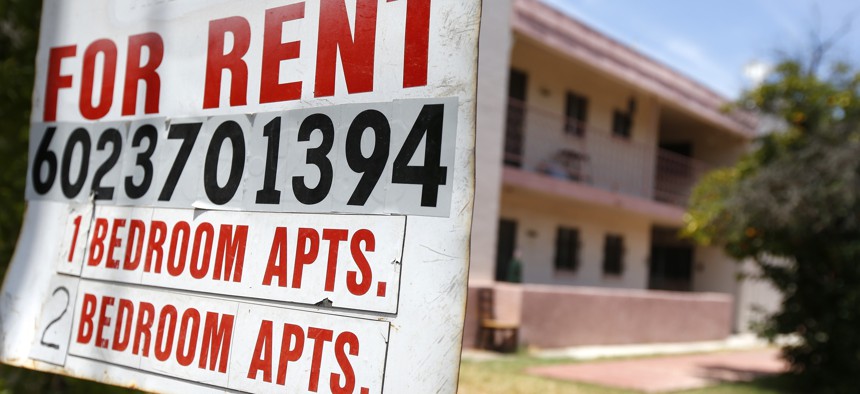As Bans Expire, Eviction Filings Rise

A rental sign is posted in front of an apartment complex Tuesday, July 14, 2020, in Phoenix. AP Photo/Ross D. Franklin
New research sheds light on the trend. Experts have warned that renters are headed towards an “eviction cliff” as the coronavirus crisis wears on and safety net measures end.
Eviction filings are on the rise in places across the U.S. where coronavirus-driven bans on eviction proceedings are expiring, according to new research.
Researchers with the Federal Reserve Bank of Cleveland looked at eviction data for 44 cities and counties where various eviction protections went into effect in the March to April timeframe. Some of these jurisdictions imposed moratoriums on eviction hearings but not filings, others on filings and hearings, and some did not ban either.
At the outset of the coronavirus crisis, the report says that eviction filings dropped sharply even in places that didn’t impose broad eviction bans. But in more recent weeks, evictions have begun to rise again—notably in places where moratoriums have ended.
In places where the bans remain in effect, the filings are still down, the researchers found.
The report uses the city of Cleveland, Ohio as an example of how evictions have trended as the bans went into effect and expired.
Eviction filings fell when a moratorium policy went into effect in the city in March. In the week after June 15, when the policy lapsed, eviction filings shot up to twice their level for the same time period last year, before falling below pre-pandemic levels in the weeks after.
More broadly the report finds that across the set of places where both filings and hearings were banned, filings were down 99% in the six weeks leading up the expiration of the bans. But in the week after the expiration, filings in those places were up 19% compared to 2019.
“Eviction filings have almost returned to their pre-pandemic levels in jurisdictions with no bans in place. Both filing and hearing bans appear to be effective at temporarily subduing eviction filings,” the report says.
The federal virus relief legislation known as the CARES Act provided a 120-day moratorium on evictions for most tenants in federally subsidized apartments. State and local emergency eviction policies are a patchwork. Around 30 states had no eviction protection rules, or ones that expired before July 1, according to ProPublica.
One issue with the bans is that they don’t necessarily prevent unpaid rent from stacking up even if a landlord can’t act to oust a renter.
A Census Bureau “Household Pulse Survey” conducted during the week of July 2 to 7 found that nearly 18% of renter respondents did not pay rent last month, or had it deferred. About 30% said they had “no” or “slight” confidence that they’d be able to make rent next month.
The Cleveland Fed report cites prior research that indicates nonpayment of rent is the reason behind almost 80% of evictions.
In Wisconsin, an eviction ban that covered Brown County, where Green Bay is located, expired on May 26, after about two months. After the ban ended, evictions increased 23% over the same period a year ago, the Green Bay Press-Gazette reported on Monday.
The local nonprofit We All Rise: African American Resource Center was cutting checks to help people cover the cost of hotels and temporary housing. But the group’s executive director, Robin Tinnon, told the Press-Gazette the center is now running low on money and has begun buying tents for people who have become homeless.
"The amount of tents that we're buying," Tinnon told the newspaper. "The amount of safe parking areas that we're trying to find families. Like we're literally buying tents because we're running out of money for emergency funds for hotels."
Americans who’d been laid off and were able to get unemployment insurance benefits had the plus of a federally-funded $600 a week boost to their normal state benefit. But those extra payments are set to go away at the end of this month.
Meanwhile, people in a number of states have complained about persistent problems with actually getting unemployment payments.
Treasury Secretary Steven Mnuchin suggested on Monday that the Trump administration and congressional Republicans could be lining up behind the idea of reducing the size of that extra unemployment insurance payment as part of a new relief bill they’re now working on.
“We’re going to make sure that we don’t pay people more money to stay home than go to work,” he said. “We want to make sure that people who can go to work safely can do so.”
The nation’s unemployment rate is very high, at around 11% last month. That’s down from 14.7% in April, but well above the 3.5% rate in February, before the virus tanked the economy.
Housing experts at the Urban Institute warned last week that the nation’s renters are headed towards an “eviction cliff” as the bans and the added unemployment benefits run out.
Steps like a national moratorium on evictions, extending the supplemental unemployment insurance benefits and boosting federal and local rental assistance are among the recommendations they put forward for addressing the issue.
The Urban Institute has estimated that it would cost almost $16 billion per month to meet renters’ needs during this crisis.
A full copy of the Federal Reserve Bank of Cleveland report can be found here.
Bill Lucia is a senior reporter for Route Fifty and is based in Olympia, Washington.
NEXT STORY: State Lawmakers Introduce Bill to Reimburse Restaurants for Costs of Stalled Reopening






